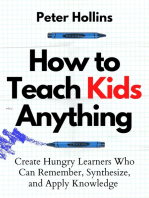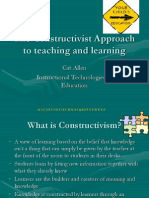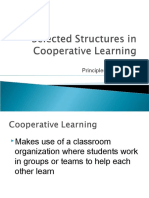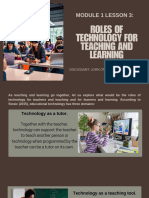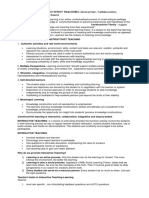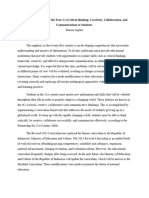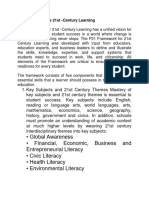Unit 2 C D
Uploaded by
Tatiana Mae Cruz MenesesUnit 2 C D
Uploaded by
Tatiana Mae Cruz MenesesUNIT 2. C.
DEVELOPING FUNCTIONAL LITERACY Empowers students to take ownership of their
learning journey. They take initiative, design
OBJECTIVES: projects, and make choices about their learning path.
Identify developing functional literacy. Students also work in small groups towards a
Interpret the participatory approach in developing common goal, sharing knowledge, responsibilities,
functional literacy. and perspectives.
WHAT IS FUNCTIONAL LITERACY? 4 Specific Goals of Student Led Instruction
• Functional literacy enables a child to continue to 1. The students are able to understand what they are
use reading, writing and calculation for his or her learning in the greatest detail possible.
own and the community’s development. 2. Empower a student with their learning; and a sense of
(UNESCO Institute for Statistics) pride and accomplishment.
3. Allows teachers to see what their students do and
KINDS OF FUNCTIONAL LITERACY don’t know, what they fully understand, and where the
• MEDIA LITERACY teacher needs to fill in the gaps of their learning.
• RELIGIOUS LITERACY 4. Improve a student’s oral communication skill.
• FINANCIAL LITERACY
• COMPUTER LITERACY Strategies: Group projects, peer tutoring, jigsaw
• LEGAL LITERACY classrooms.
• SCIENTIFIC LITERACY Impact: Develops teamwork, communication, problem-
• HEALTH LITERACY solving, and leadership skills. Students take ownership
• CIVIC LITERACY of their learning, actively engage with content, and learn
from their peers.
PARTICIPATORY APPROACH
•Developed by a brainchild of Brazilian language INQUIRY-BASED CLASSROOM ENVIRONMENT
educator Paulo Freire. According to Lenox (1993) teachers must be
• Participatory Approach also known as "Freirean prepared to “teach students to become critical
Approach". thinkers, intellectually curious observers, creators,
•Freire is the author of the book "Pedagogy of the and users of information.” The goal is to prepare
Oppressed". students early on to “learn how to learn” and carry
these skills into other areas of their lives so that they
• The main goal of this approach is to have EVERY can be independent seekers and consumers of
student, as well as the teacher, actively participating in information throughout their lives. Teachers of all
the activities. subjects must blend their traditional fact-based
• This approach changes the role of the teacher, instead approach with an emphasis on learner-based inquiry
of giving instructions and then stepping back to allow and the scientific inquiry process (Lenox 1993). This
students to work, the teacher works together with the means shifting some of the responsibility of gaining
students. knowledge to the student and allowing students to
•We must use REALISTIC MATERIALS. develop questions. Strategies to search for answers
and formulate conclusions.
Participatory Approach through the concept of Freire
opposes the old "Banking Method" of teaching and As a teacher, you are most likely familiar with a
advocates for the learners to co-create knowledge. KWL chart that depicts what students KNOW (K),
what they WANT to know (W), and then eventually,
UNIT 2. D what they LEARN (L). Inquiry-based learning
21ST CENTURY LITERACY SKILLS AND focuses on the “want to know” portion of a KWL
TEACHING RESOURCES chart. However, true inquiry involves a student
seeking the answers themselves, as opposed to a
Introduction teacher simply providing the information through
The rapid pace of change in the 21st century demands lecture and direct teaching.
more than just traditional literacy skills. Today's students
need 21st century literacy skills like critical thinking, Strategies: Open-ended questions, hands-on activities,
collaboration, communication, and creativity to thrive in student-driven research.
an information-rich and interconnected world. This Impact: Cultivates curiosity, critical thinking,
presentation explores five innovative strategies that information literacy, and independent learning. Students
foster these essential skills and their impact on student become active investigators, asking questions, seeking
learning. answers, and evaluating information critically.
21st Century Literacy Skills and Teaching Resources COLLABORATIVE ACTIVITIES
1. Student-led Learning (Cooperative Learning) These are the tasks or projects that involve the joint
2. Inquiry-based Classroom Environment efforts of multiple individuals or groups working
3. Collaborative Activities together towards a common goal. These activities
4. HOTS Activities promote teamwork, communication, and the sharing
5. Creative Learning of ideas and skills.
Collaborative work in the classroom develops
STUDENT-LED LEARNING (COOPERATIVE students’ skills in learning to live together with
LEARNING) classmates of diverse background.
Teachers’ ought to teach collaboration, instead of Improves decision-making abilities
competition. Enhances creativity and innovation
Collaboration happens when students know how to Prevents rote memorization
work well with others to accomplish a given task or Encourages metacognition
solve a problem at hand.
Strategies:
Think-Pair-Share
Debates
Role-Playing
Group Science Experiments
Group Research
Peer Teaching
Impacts:
Improves teamwork and collaboration skills.
Enhances learning and retention.
Develops the communication and critical
thinking skills of students. CREATIVE LEARNING
Increases motivation and engagement among Creativity in the classroom is not what the perceived
students. view of creativity is. It is not the use of dance, art or
Encourages peer learning and support. role play to enhance a point or subject, but the
method of teaching which has the student think out
HIGHER-ORDER THINKING SKILLS (HOTS) of the box. This creative thinking is a method of
ACTIVITIES turning the student into a problem solver and giving
These are designed to engage students in critical that student a “toolbox” with which to approach
thinking, analysis, synthesis, and evaluation. These problems. The creative teacher must nurture these
activities go beyond basic recall of information and skills and instil in those students the potential which
encourage students to apply, analyze, and create is inside.
knowledge.
It distinguishes critical thinking skills from low- How is creative teaching and creative learning related?
order learning outcomes, such as those attained by Teaching creatively is defined as ‘teacher
rote memorization. imaginative approaches to make learning more
It is a thinking activity that combines several interesting and effective’ while teaching for
behaviors of describing material, analyzing, creativity are ‘forms of teaching’ that are intended to
representing, concluding and building relationships develop young people’s own creative thinking or
involving the most basic mental activities. behavior. (NACCCE, 1999).
HOTS is based on various taxonomies of learning,
particularly the one created by Benjamin Bloom in In his research, Clark (1996) found out that creative
his 1956 book, "Taxonomy of Educational teachers showed flexibility, accepted alternative
Objectives: The Classification of Educational suggestions, encouraged expressions of ideas and
Goals." tolerated humor. He described creativity –fostering
By developing higher-order-thinking skills, the teachers as those who:
schools today can inculcate the digital fluencies, - encourage students to learn independently
while overcoming limitations inherent in digital - have a cooperative socially integrative style
technology, resulting in superficial and mediocre of teaching
learning skills of new learners. - do not neglect the mastery of factual
knowledge
- promote self-evaluation
- takes questions seriously
- offer opportunities to work with varied
materials under different conditions
-
Strategies: Digital storytelling, problem-solving through
art, design thinking.
Impact: Fosters creativity, problem-solving, and
communication skills. Students express themselves
creatively, approach challenges with innovative
solutions, and communicate their ideas effectively.
Benjamin Blooms (1956) Lorin Anderson (2001) CONCLUSION
By incorporating these innovative strategies into
Strategies: Activities focused on analysis, evaluation, your teaching, you can equip your students with the
synthesis, and creation. essential skills they need to thrive in the 21st
Impacts: century. These approaches cultivate critical thinking,
Develops the problem-solving, communication collaboration, communication, creativity, and
and critical thinking skills of students problem-solving, preparing students for success in
both academic and personal endeavors. Remember,
the key is to tailor these strategies to your students'
needs and interests, fostering a dynamic and
engaging learning environment that empowers them
to become lifelong learners and responsible citizens.
You might also like
- How to Teach Kids Anything: Create Hungry Learners Who Can Remember, Synthesize, and Apply KnowledgeFrom EverandHow to Teach Kids Anything: Create Hungry Learners Who Can Remember, Synthesize, and Apply KnowledgeNo ratings yet
- MODULE 5 Building and Enhancing New Literacies Across The Curriculum100% (1)MODULE 5 Building and Enhancing New Literacies Across The Curriculum13 pages
- Alvarez Givengrace Lesson Plan Developing Functional Literacy and 21ST Century Literacy Skills and Teaching ResourcesNo ratings yetAlvarez Givengrace Lesson Plan Developing Functional Literacy and 21ST Century Literacy Skills and Teaching Resources12 pages
- Ced110 - Building and Enhancing New Literacies Across The CurriculumNo ratings yetCed110 - Building and Enhancing New Literacies Across The Curriculum13 pages
- The Futures of Learning 3 - What Kind of Pedagogies For The 21st Century - UNESCO Digital LibraryNo ratings yetThe Futures of Learning 3 - What Kind of Pedagogies For The 21st Century - UNESCO Digital Library21 pages
- 2C2IR-IMs-DEVELOPMENT-1_(4)(2)_(3)(2) (1)No ratings yet2C2IR-IMs-DEVELOPMENT-1_(4)(2)_(3)(2) (1)59 pages
- Pamantasan NG Cabuyao: College of EducationNo ratings yetPamantasan NG Cabuyao: College of Education16 pages
- Quality Teachers Respect Learners: Thus, They Rely On Constructivist Teaching & Learning ApproachesNo ratings yetQuality Teachers Respect Learners: Thus, They Rely On Constructivist Teaching & Learning Approaches32 pages
- Quality Teachers Respect Learners: Thus, They Rely On Constructivist Teaching & Learning ApproachesNo ratings yetQuality Teachers Respect Learners: Thus, They Rely On Constructivist Teaching & Learning Approaches32 pages
- The Constructivist Approach To Teaching and Learning: Cat Allen Instructional Technologies in EducationNo ratings yetThe Constructivist Approach To Teaching and Learning: Cat Allen Instructional Technologies in Education17 pages
- What Kind of Pedagogies For The 21st CenturyNo ratings yetWhat Kind of Pedagogies For The 21st Century5 pages
- Understanding The Special Education Needs of Learners in Difficult CircumstancesNo ratings yetUnderstanding The Special Education Needs of Learners in Difficult Circumstances56 pages
- Introductiontocooperativelearning 140827073247 Phpapp01 PDFNo ratings yetIntroductiontocooperativelearning 140827073247 Phpapp01 PDF49 pages
- Roles of Technology for Teaching and Learning.pptx 1No ratings yetRoles of Technology for Teaching and Learning.pptx 123 pages
- Unit 2. Teaching Strategies for the Development of Literacy Skills and Teaching Resources (1)No ratings yetUnit 2. Teaching Strategies for the Development of Literacy Skills and Teaching Resources (1)6 pages
- Teaching Implications For Achieving Best Practices in 21st CenturyNo ratings yetTeaching Implications For Achieving Best Practices in 21st Century7 pages
- Teacher Strategies in critical thinkingNo ratings yetTeacher Strategies in critical thinking23 pages
- Integrating Innovation Skills in The Common Core For College & Career ReadinessNo ratings yetIntegrating Innovation Skills in The Common Core For College & Career Readiness31 pages
- The 2C-2I-1R: Teaching and Learning Approaches Across Learning Areas That Support Teacher Practice100% (5)The 2C-2I-1R: Teaching and Learning Approaches Across Learning Areas That Support Teacher Practice34 pages
- Lesson 4.1 Teaching Modalities Methods and StrategiesNo ratings yetLesson 4.1 Teaching Modalities Methods and Strategies31 pages
- Humanistic-Constructivist Theories 2013No ratings yetHumanistic-Constructivist Theories 201329 pages
- 1 5 Pedagogical Approaches in K To 12 2No ratings yet1 5 Pedagogical Approaches in K To 12 249 pages
- City Life and Garbage Disposal in Kochi-Challenges and OpportunitiesNo ratings yetCity Life and Garbage Disposal in Kochi-Challenges and Opportunities16 pages
- Saving The Earth Starts With You: Care For God'S CreationNo ratings yetSaving The Earth Starts With You: Care For God'S Creation13 pages
- narrative techniques class 12 by taniyaNo ratings yetnarrative techniques class 12 by taniya17 pages
- Week Two Homework Problem Solutions: Fundamentals of ! Fluid PowerNo ratings yetWeek Two Homework Problem Solutions: Fundamentals of ! Fluid Power6 pages
- Statistical Actuarial Estimation of The CapitationNo ratings yetStatistical Actuarial Estimation of The Capitation21 pages
- Gateway College of Architecture and Design SONIPAT 131001No ratings yetGateway College of Architecture and Design SONIPAT 13100151 pages
- PD - OVC Administration and Support Officer (ANUO5)No ratings yetPD - OVC Administration and Support Officer (ANUO5)2 pages
- M2 Week 2 CHAP 6 CHEMICAL APECT OF DOCUMENT EXAMINATION100% (1)M2 Week 2 CHAP 6 CHEMICAL APECT OF DOCUMENT EXAMINATION30 pages
- Regenerative Bhutan Report Summary - Vclean100% (1)Regenerative Bhutan Report Summary - Vclean15 pages
- Geomagnetic Disturbances Impacts on Power Systems: Risk Analysis and Mitigation Strategies 1st Edition Olga Sokolova - The ebook is ready for download to explore the complete content100% (2)Geomagnetic Disturbances Impacts on Power Systems: Risk Analysis and Mitigation Strategies 1st Edition Olga Sokolova - The ebook is ready for download to explore the complete content55 pages
- Maize mid-density genotyping services _ ExcellenceinbreedingNo ratings yetMaize mid-density genotyping services _ Excellenceinbreeding4 pages

